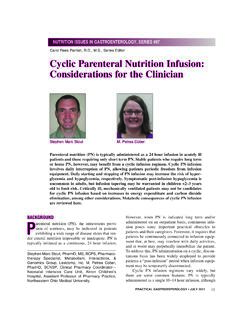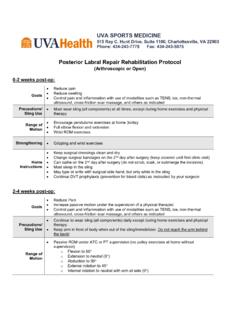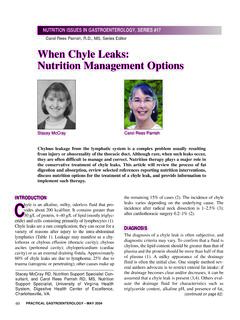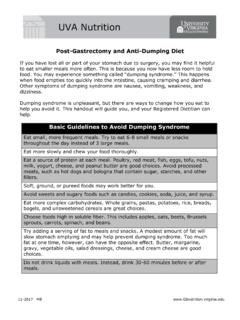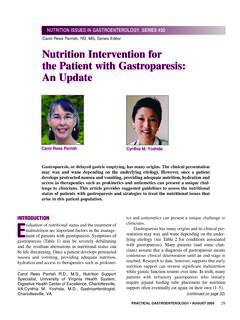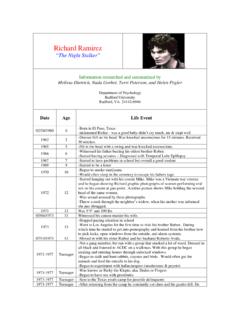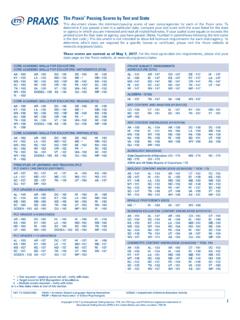Transcription of Near-Death Experiences and Attempted Suicide
1 Bruce Greyson 11. clinical studies of NDEs published to date suggest a marked decrease with deceased loved ones and suggestion of survival of bodily death , should foster suicidal ideation (Kastenbaum, 1979). However, the few in subsequent suicidal intent and behavior among those experiencing NDEs. Systematic investigation of NDEs and Suicide attempts may provide a more sophisticated understanding of the role of one's con- Near-Death Experiences and Attempted Suicide cept of death in self-destructive behavior. Data on NDEs and Suicidal Ideation Bruce Greyson, MD. University of Michigan Medical Center, Ann Arbor Among the sample of NDE reporters described by Greyson and Stevenson (1980), 20 claimed that the NDE made them feel more nega- tive toward Suicide than they had felt previously, 18 acknowledged no change in their attitude toward Suicide , and none stated that the NDE. made them feel more positive toward Suicide .
2 These attitude changes ABSTRACT: Attempted Suicide is correlated with an increase subsequent risk of com- were not correlated with any Experiences , expectations, or beliefs prior mitted Suicide . However, preliminary data and psychodynamic hypotheses suggest that serious Suicide attempts followed by transcendental Near-Death Experiences to the NDE, with any demographic parameters, nor with the manifest (NDEs) may decrease rather than increase subsequent overt Suicide risk, despite the content of the NDE. NDEs' apparent " romanticization" of death . Studies of NDEs and of their influence on Ring (1980) reported that Suicide attempters were less likely to suicidal ideation are proposed which may yield greater understanding of self- destructive urges and new strategies of Suicide prevention. experience NDEs (eight NDE reports out of 24 patients interviewed). than either accident victims or victims of illness (40 NDE reports out of 78 patients interviewed).
3 Suicide attempters tended to report ND Es Studies of persons who have Attempted Suicide have reported sub- of shorter duration, including feelings of relief or peace, bodily detach- sequent committed Suicide rates greater than 50 to 100 times that of ment, and drifting in a void; they tended not to report what Ring des- the general population (Pederson, Awad, and Kindler, 1973; Tuckman, cribed as later sequential stages of an NDE: impressions of experi- Youngman, and Kreizman, 1968). Furthermore, those Suicide encing a tunnel, a light, reunion with deceased loved ones, or a realm of attempters who come close to death have a higher subsequent Suicide preternatural beauty. rate than those who do not come close to death (Rosen, 1976). How- In a more recent report, the same investigative team found that ever, recent reports of profound subjective events with transcendental among 30 Suicide attempters who came close to death , the incidence of or mystical elements, the Near-Death Experiences (NDEs) which some NDE recall was not significantly different from that among victims of persons experience on the threshold of death (Stevenson and Greyson, illness or accidents (Ring and Franklin, 1980).)
4 They further report that 1979; Greyson and Stevenson, 1980), suggest the possibility that some those NDEs described by Suicide attempters were not qualitatively nearly-completed Suicide attempts may decrease rather than increase different from those reported by others, and that none was predomi- the attempter's subsequent suicidal ideation. nantly unpleasant. Nevertheless, they noted that despite the positive Shneidman (1971) hypothesized that "romanticized" notions of nature of these Experiences , they appeared to promote a strongly anti- death , ie, notions of death as other than an involuntary naughtment or Suicide orientation among those reporting them. annihilation, tend to promote Suicide . According to this hypothesis, Rosen (1975) interviewed seven survivors of Suicide attempt by NDE reports, which tend to characterize the process of dying by posi- jumps from bridges, and found some features of NDE s in each one.
5 Tive affect, by absence of anxiety or pain, and by a sense of reunion Though none reported panoramic memory or life review Experiences , most experienced a distortion in their sense of time, and all reported The author wishes to thank Ian Stevenson, , Russell Noyes, Jr. , , Kenneth feelings of tranquility, peacefulness, and transcendence of bodily Ring, , and James E . Alcock, , fo r their helpful comments on this death . On follow-up, only one had repeated a Suicide attempt, which manuscript. was not lethal. While this sample is necessarily small, the absence of Suicide and Life-Threatening B ehauior, Vol. 11(1/, Spring 1981 subs: quent mor tality among those NDE reporters contrasts with the 10 0363-0234/81/1300 0010$ 1981 Human Sciences Press 12 Suicide and Life-Threatening Behavior Bruce Greyson 13. 25 subsequent completed suicides, with a mean survival interval of may reduce suicidal ideation by providing a more favorable per- only years, among 515 persons who had been restrained from spective on one's self-worth and position in life (Lewis and Butler, jumping off the same bridges (Seiden, 1968), some of whom might have 1974; Grof and Halifax, 1978).)
6 Greyson and Stevenson (1980) reported gone on to have a NDE if not restrained. a significant correlation between the occurrence of the life review and Buckman and Greyson (1977) described a patient with a pathological attitude changes following an NDE. grief reaction whose third near-fatal Suicide attempt culminated in a In patients for whom Attempted Suicide may be a form of sacrifice or NDE in which he seemed to be reunited with deceased loved ones in a punishment, the ego- death experienced during a NDE, in which the transcendental realm. The patient then underwent a sudden and sus- patient seems to survive despite the apparent cessation of ego func- tained personality change, with cessation of his self-destructive sui- tions, may serve as a sufficient substitute for the death of the self. This cidal behavior and alcoholism. "egocide" may be seen as a symbolic Suicide , as a sacrifice of con- flictual ego parts, or as a compromise between the wish to live and the Psychodynamic Hypotheses on NDEs and Suicidal Ideation wish to die (Rosen, 1976; Waltzer, 1968; Noyes, 1980).
7 The suicidal behavior of certain other patients may not be attempts to die but Prince and Savage (1966) described mystical states as one form of rather attempts to transcend the ego, to escape from painful emotions regression in the service of the ego. The NDE may be a particular and sensations (Grof and Halifax, 1978); in other patients, suicidal example of such regression as a response to the threat of death , the fre- acts may be an attempt to confront death in order to renew or validate quently reported feelings of peace and contentment being a mani- one's sense of being alive (Taylor, 1978; Noyes, in press). In either festation of the denial of death . Clark (1966) and Horton (1976) have circumstance, the transcendental NDE may satisfy cravings for ego reported dissipation of suicidal behavior following regression to sym- death and restore a sense of purpose to life. biotic or primary narcissistic states through mystical Experiences .
8 In Many patients attribute their disavowal of Suicide to a strengthened the patient described by Buckman and Greyson (1977), mentioned belief in post-mortem existence, as a result of their NDE (Ring, 1980;. above, renewal of the symbiotic attachment to his deceased mother Noyes, 1979; Noyes, 1980). Though this belief is a primary factor in the appeared to reverse a suicidal pathological grieving process. Grof and romanticization of death , it appears to romanticize life as well: belief Halifax (1978) reported therapeutic changes in suicidal patients fol- that death is not cessation seems to enhance a sense of value or mean- lowing psychedelic-induced " death -rebirth" Experiences similar to ing of life. Conviction in the presence of an afterlife may also inhibit NDEs, in which feelings of isolation and alienation are replaced by a Suicide by enhancing one's self-esteem and primary sense of worth.
9 Sense of cosmic unity arid transcendence of the subject-object dichotomy, reminiscent of the primal union with the mother. Noyes and Kletti (1976) reported that an NDE may enhance a In addition to gratifying symbiotic longings, regression to an patient's self-image based on his or her experience of having faced oceanic state may leave the patient with a primary sense of worth and death with serenity and acceptance. Grof and Halifax (1978) described meaning not contingent upon external circumstances. As the Suicide the mobilization and discharge of destructive energies during the attempter having a NDE Experiences a sense of cosmic unity, he or she NDE. Both of these mechanisms may contribute to the reduction of often decathects unmet wordly goals and begins to view his or her suicidal ideation following a NDE. individual losses as irrelevant from a transpersonal perspective (Ring, Finally, there is the possibility that for some Suicide attempters, a 1980; Grof and Halifax, 1978).
10 Greyson and Stevenson (1980) found NDE may be such an unpleasant experience as to dispel any subse- negative changes in attitude toward Suicide after a NDE to be cor- quent death wishes. This does not appear to be the case for the major- related with attitude changes toward material possessions, sex or mar- ity of NDE reporters, however, as a reduced fear of death has been riage, personal power or fame, family or friends, and the meaning of repeatedly documented as a frequent and longlasting consequence life. (Kalish, 1969; Noyes and Slymen, 1971; Sabom, 1978; Noyes, 1980), Another commonly reported feature of NDEs which may exert a sig- and, among the sample of NDE reporters described by Greyson and nificant therapeutic effect is the panoramic memory or "life review." Stevenson (1980), negative attitude changes toward Suicide following This re-evaluation of the patient's life may help to resolve and inte- the NDE were correlated with feelings of peacefulness or contentment grate old conflicts and to differentiate real from neurotic guilt, and during the NDE (chi square = , df = 1; p <.)
